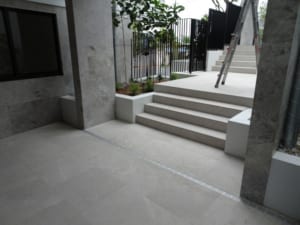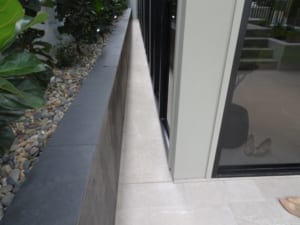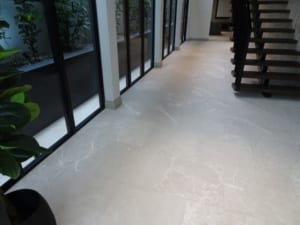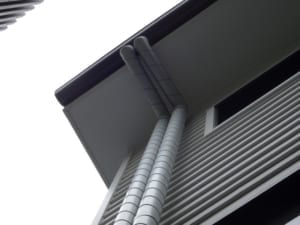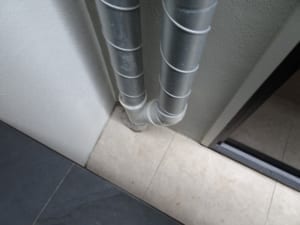Defects built into a New House and problems they cause.
Learn how defects with new house design can cause short and long term problems for home owners. QBIS.
Water entry to interior of new house is inevitable
Poor design: Steps leading down to main entry of this new house are higher than living slab level, creating a pit.
Although a drain has been fitted, it is unlikely to allow water to escape quickly enough before entering the house. What makes matters worse, is when the drain becomes blocked.
Recommendation on avoiding water entry to ground floor living area:
Create an open trench from the drain level through the retaining wall to a lower point of the property and/or to the street. This would need to be sufficient in its size to allow water to escape, in adverse weather conditions. The drain would need to be checked regularly.
Steps leading down into entry with insufficient drainage and level between paving and inside slab.
Low area creating a pit at front of the house with inadequate drainage. This will trap water with no chance of it being diverted to the street. Trench required between the building and pier with fall to the street.
Insufficient level between paving and inside slab level of living area:
Paving has been fitted only 30 mm lower than the inside slab level of a living area. This is likely to allow water entry to interior of the house in differing weather conditions, in particular a heavy downpour when drains will not allow water to escape quickly enough.
From the inside showing inadequate differences of levels between paving and inside slab.
Recommended rectification of surface drainage problem:
Fit large open drains that can be easily checked and kept clear of debris with sufficient fall to lower point of the property.
Roof drainage problem.
Additional down-pipe has been fitted to help stop the roof gutter from overflowing. Next photo shows why this is pointless and will not work.
Two down-pipes connected to the same size storm-water pipe reducing its effectiveness by half. This will cause backflow of water and possible rot to concealed timber of the eaves.
How to eliminate roof drainage problem:
Fit:
- More downpipes.
- Additional storm-water pipes to match down-pipes.
- Fit relief slots to front edge of roof gutter to allow water to escape at front of gutter rather than the back.
Unfortunately it is not practical to have enough stormwater pipes that exit to the street, this is where reliefs are likely to help.
What builders need to do before building defects into houses:
- Builders must question faults in design if they consider them impractical.
- Recommend workable solutions.
- Design faults must be identified in early stages, before construction.
- A healthy relationship must be developed between builder and designer, in best interest of the client.
Bottom line: Builders are responsible for the faults they build.


